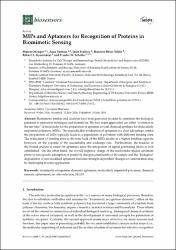| dc.contributor.author | Menger, Marcus | |
| dc.contributor.author | Yarman, Aysu | |
| dc.contributor.author | Erdossy, Julia | |
| dc.contributor.author | Yıldız, Hüseyin Bekir | |
| dc.contributor.author | Gyurcsanyi, Robert E. | |
| dc.contributor.author | Scheller, Frieder W. | |
| dc.date.accessioned | 2021-01-08T21:51:27Z | |
| dc.date.available | 2021-01-08T21:51:27Z | |
| dc.date.issued | 2016 | |
| dc.identifier.issn | 2079-6374 | |
| dc.identifier.uri | http://doi.org/10.3390/bios6030035 | |
| dc.identifier.uri | https://hdl.handle.net/20.500.12846/268 | |
| dc.description | Menger, Marcus/0000-0002-6856-6663; Gyurcsanyi, Robert E./0000-0002-9929-7865 | en_US |
| dc.description | WOS:000381858900008 | en_US |
| dc.description | PubMed: 27438862 | en_US |
| dc.description.abstract | Biomimetic binders and catalysts have been generated in order to substitute the biological pendants in separation techniques and bioanalysis. The two major approaches use either "evolution in the test tube" of nucleotides for the preparation of aptamers or total chemical synthesis for molecularly imprinted polymers (MIPs). The reproducible production of aptamers is a clear advantage, whilst the preparation of MIPs typically leads to a population of polymers with different binding sites. The realization of binding sites in the total bulk of the MIPs results in a higher binding capacity, however, on the expense of the accessibility and exchange rate. Furthermore, the readout of the bound analyte is easier for aptamers since the integration of signal generating labels is well established. On the other hand, the overall negative charge of the nucleotides makes aptamers prone to non-specific adsorption of positively charged constituents of the sample and the "biological" degradation of non-modified aptamers and ionic strength-dependent changes of conformation may be challenging in some application. | en_US |
| dc.description.sponsorship | German Ministry of Education and Research (BMBF)Federal Ministry of Education & Research (BMBF) [031B0029B]; Deutsche ForschungsgemeinschaftGerman Research Foundation (DFG) [EXC314]; Lendulet program of the Hungarian Academy of Sciences [LP2013-63]; ERA-Chemistry [OTKA NN117637]; Hungarian Scientific Research FundOrszagos Tudomanyos Kutatasi Alapprogramok (OTKA) [OTKA K104724] | en_US |
| dc.description.sponsorship | This work was supported by the German Ministry of Education and Research (BMBF No. 031B0029B) and by the Deutsche Forschungsgemeinschaft project number EXC314. The financial support of the Lendulet program of the Hungarian Academy of Sciences (LP2013-63), ERA-Chemistry (2014, 61133; OTKA NN117637), and the Hungarian Scientific Research Fund (OTKA K104724) is gratefully acknowledged. | en_US |
| dc.language.iso | eng | en_US |
| dc.publisher | Mdpi | en_US |
| dc.rights | info:eu-repo/semantics/openAccess | en_US |
| dc.subject | Biomimetic Recognition Elements | en_US |
| dc.subject | Aptamers | en_US |
| dc.subject | Molecularly Imprinted Polymers | en_US |
| dc.subject | Chemical Sensors | en_US |
| dc.subject | Aptasensors | en_US |
| dc.subject | In Vitro Selection | en_US |
| dc.subject | Selex | en_US |
| dc.title | MIPs and aptamers for recognition of proteins in biomimetic sensing | en_US |
| dc.type | Review | en_US |
| dc.relation.journal | Biosensors-Basel | en_US |
| dc.identifier.volume | 6 | en_US |
| dc.identifier.issue | 3 | en_US |
| dc.relation.publicationcategory | other | en_US |
| dc.contributor.department | TAÜ, Fen Fakültesi, Moleküler Biyoteknoloji Bölümü | en_US |
| dc.contributor.institutionauthor | Yarman, Aysu | |
| dc.identifier.doi | 10.3390/bios6030035 | |
| dc.identifier.wosquality | N/A | en_US |
| dc.identifier.scopusquality | Q1 | en_US |

















